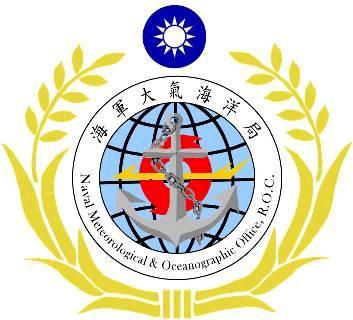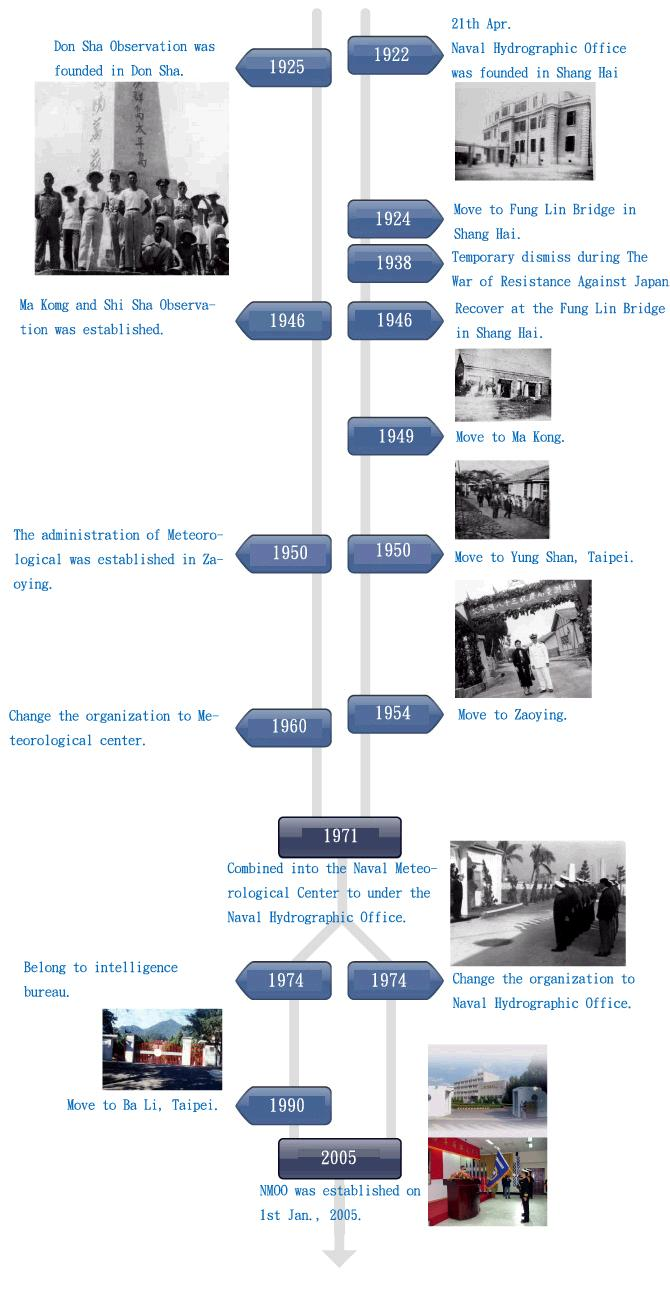
Blue sky and White cloud Matel:
It is stand for the navy of our country, the duty to persist in protecting our country and
people.
Rice :
It is stand for that Republic of China is established on agriculture, to pursue the spirit of
peace and united;It is stand for logistical is the mission to supply the naval battle ships.
Anchor and Chain:
It is stand for inheriting and uniting, to declare to make up one’s mind in protecting
Taiwan safety untill to die.
Circle rope:
It is stand for the strength never shake navy in Taiwan Strait.
Earth, Typhoon, The arm of Wind Speed and Direction:
It is meaning which the filed intelligence and meteorological GIS (Geographic
Information System) is the navy strategy and logistic demand. It is benefit for the
maneuvers and battle analysis and navigation, to support the survey technique and
meteorological forecast to our Navy.
History

Naval Meteorologic and Oceanographic Office (NMOO) is combined with Naval Hydrographic Office and Naval Meteorological Center.
1.Naval Hydrographic Office:
(1) River and Sea Survey are relative to national defense and sea rights, so Naval Hydrographic Office was established in Wu Song, Shin Hai on 21th Feb. 1922(The ruins of Wu Song Naval Academy); It is moved to new building of ShingXieng Load in Shin Hai on 2ed Aug. 1929, reorganize and expend in Jan. 1930.; The official service was halt in Dec. 1937 because of The War of Resistance Against Japan. While all officers assigned to other units or retired immediately, the survey ships were transformed to battle ships. After the victory ofthe War of Resistance Against Japan, it recovered its organization in Shang Hai.
(2)The Government is retreated to Pong Hu. It reduced organization and moved to Yuan Shan, Taipei in Jan. 1950. It reorganized in Sep., 1954. Transforming the class to department. It moved to Zaoying in Sep., 1954.
(3)To follow the policy, the bureau combined Tidal Department and Process Department into Map Library. The Map Library reorganized and was belong to Mapping and Navigation Department in 1970. The Navy headquarters simple the Naval Meteorological Center to under the Naval Hydrographic Office and changed name into Naval Survey and Meteorological Bureau. In 1974,the Naval Meteorological Center was belong to intelligence bureau, the Naval Hydrographic Office changed name to Naval Hydrographic Office by Navy headquarters.
2.Naval Meteorological Center:
Naval Meteorological Bureau was established in Zaoying Taiwan on Dec. 1st 1949. It was reorganized into the Navy Meteorological Stationon 1st July 1950; It was extent to the Naval Meteorological Center on 16th Oct. 1960; It reorganized to under Naval Survey and Meteorological Bureau on 1st Oct., 1971.; It was organized in the Intelligence Bureau of Naval Headquarters on 1st Jun., 1976.; It moved from Zaoying to Ba Li county, Taipei on 1st Mar. 1990.; At the same time, Taipei Meteorological Observation was moved to Zaoying, changed name to Zaoying Meteorological Observation Station.; The Hua Lien Meteorological Observation Station is closed on 20th April, 1999. It was renewed and organized Ocean Forecast Department, Digital Data Department and Observation Supply Department, andthe meteorological units was following: Zaoying, Ma Kong, Suao, Don-Sha and Nan-Sha Meteorological Observation.
3. Naval Meteorological and Oceanographic Office:
Naval Meteorological and Oceanographic Office is established on 1st Jan., 2005. It is focus on the principles of “fine organization” and “function-oriented”. By integrating function and sampling the units to improve organization effects. Following the policy of Naval Headquarters, integrating the Naval Meteorological center and the Naval Hydrographic Office into Naval Meteorological and Oceanographic Office(NMOO). The advantage of NMOO can fully charge of the energy of battle environment, enhance the transparency of battlefields, shorten the decision-making reaction time. Building the advantage of intelligence to new force the intercept attack in high seas, and complete all tasks and mission indeed.